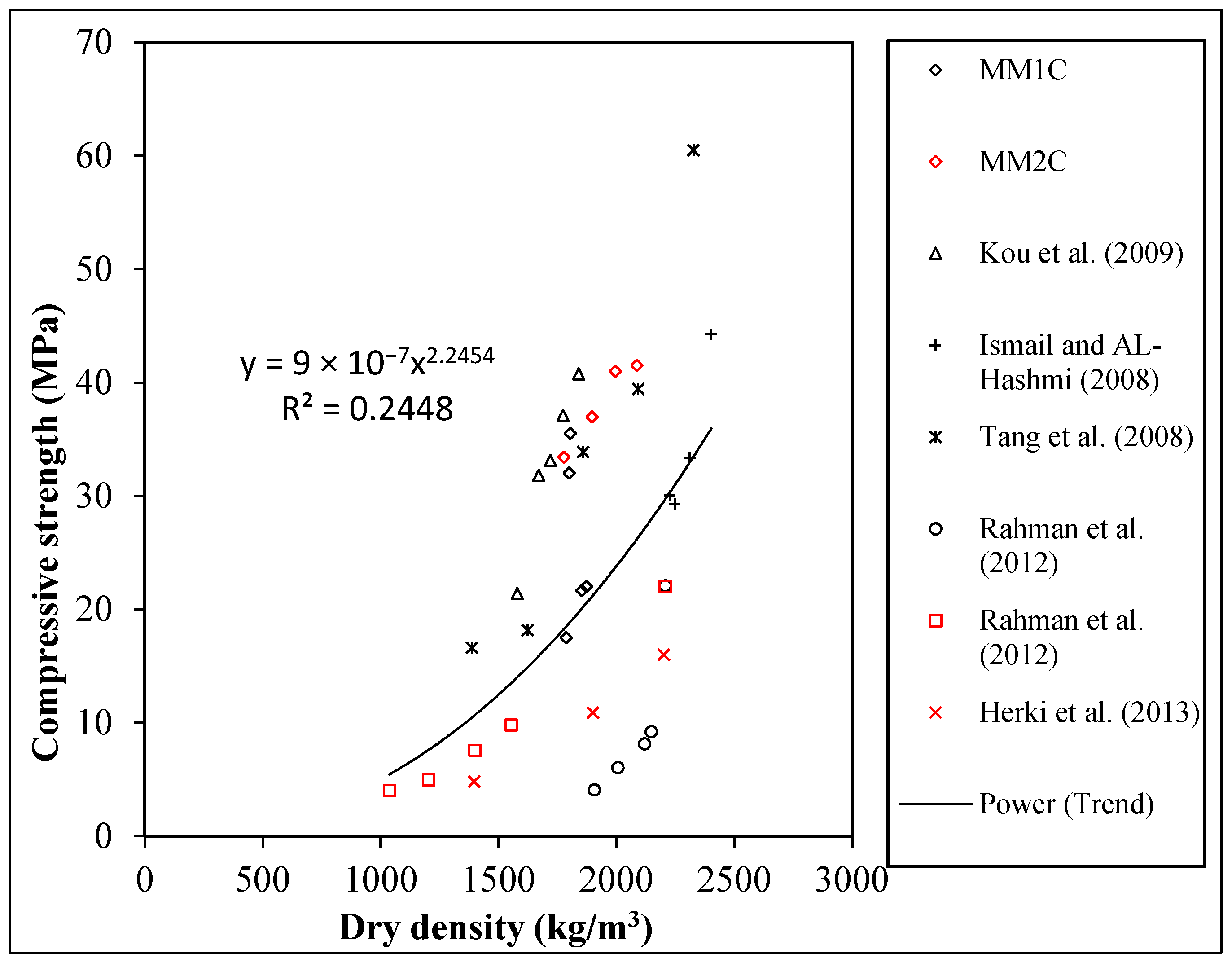A Sustainable Alternative for Green Structural Lightweight Concrete: Performance Evaluation
Abstract
1. Introduction
2. Trail Mix, Optimization and Selection for Detailed Investigation
3. Materials and Methodology
4. Results and Discussions
4.1. Physical Properties
4.1.1. Dry Density
4.1.2. Abrasion Resistance
4.1.3. Drying Shrinkage
4.2. Mechanical Properties
4.2.1. Splitting Tensile Strength
4.2.2. Bending Strength
4.3. Durability Indicator
4.4. Discussion
5. Conclusions
- Out of eight manmade plastic aggregates having different plastic and filler types, two, i.e., the first made by 70% DS and 30% LLDPE (MM1) and the second made by 50% QF and 50% PET (MM2), were selected as the optimized aggregate series based on the performance of concrete mixes with regard to compressive strength, durability indicator, i.e., chloride ion penetration, and availability of the raw material.
- The results of the physical properties analyzed in terms of compressive strength give rise to the best two contenders, i.e., MM1 and MM2 at 25% and 100% replacement fractions, respectively. On the other hand, the mechanical properties generally displayed a decreasing trend with increase in the manmade plastic aggregate replacement fractions; however, MM1 and MM2 at 25% and 100% replacement fractions, respectively, fulfilled the criteria for structural lightweight concrete, i.e., ASTMC330/C330M-14 [26].
- From the results of chloride ion penetration resistance, it was found that the aggregates made by 70% DS and 30% LLDPE were suitable for the projects having relatively low contact with chloride ions, while the aggregates made by 50% QF and 50% PET can be used for structural lightweight concrete applications irrespective of chloride levels. The brittleness ratio and structural efficiency also supported the use of MM1CA and MM2CD for structural lightweight concrete applications.
- Finally, two aggregates, i.e., 70% DS-30% LLDPE and 50% QF-50% PET at the replacement fractions of 25% and 100%, were proposed for structural lightweight purposes with low and relatively high strength and chloride-based durability requirements, respectively. As a whole, the current study provides an alternative approach to target the sustainable ways for producing lightweight structural concrete by the utilization of plastic waste.
Funding
Informed Consent Statement
Acknowledgments
Conflicts of Interest
References
- Wang, J.; Zheng, K.; Cui, N.; Cheng, X.; Ren, K.; Hou, P.; Feng, L.; Zhou, Z.; Xie, N. Green and Durable Lightweight Aggregate Concrete: The Role of Waste and Recycled Materials. Materials 2020, 13, 3041. [Google Scholar] [CrossRef] [PubMed]
- Felicetti, R.; Gambarova, P.G.; Bamonte, P. Thermal and mechanical properties of light-weight concrete exposed to high temperature. Fire Mater. 2012, 37, 200–216. [Google Scholar] [CrossRef]
- Xu, Y.; Jiang, L.; Xu, J.; Li, Y. Mechanical properties of expanded polystyrene lightweight aggregate concrete and brick. Constr. Build. Mater. 2012, 27, 32–38. [Google Scholar] [CrossRef]
- Cheng, C.M.; Su, D.G.; He, J.; Jiao, C.J. Compressive Strength of Organic Lightweight Aggregate Concrete. Adv. Mater. Res. 2011, 374–377, 1531–1536. [Google Scholar] [CrossRef]
- Bogas, J.A.; Gomes, M.G.; Gomes, A. Compressive strength evaluation of structural lightweight concrete by non-destructive ultrasonic pulse velocity method. Ultrasonics 2013, 53, 962–972. [Google Scholar] [CrossRef] [PubMed]
- Zhang, M.-H.; Dang, L.; Paramasivam, P. Shrinkage of high-strength lightweight aggregate concrete exposed to dry environment. ACI Mater. J. 2005, 102, 86–92. [Google Scholar]
- Kılıç, A.; Atiş, C.D.; Yaşar, E.; Özcan, F. High-strength lightweight concrete made with scoria aggregate containing mineral admixtures. Cem. Concr. Res. 2003, 33, 1595–1599. [Google Scholar] [CrossRef]
- Albano, C.; Camacho, N.; Hernández, M.; Matheus, A.; Gutiérrez, A. Influence of content and particle size of waste pet bottles on concrete behavior at different w/c ratios. Waste Manag. 2009, 29, 2707–2716. [Google Scholar] [CrossRef]
- Ismail, Z.Z.; Al-Hashmi, E.A. Use of waste plastic in concrete mixture as aggregate replacement. Waste Manag. 2008, 28, 2041–2047. [Google Scholar] [CrossRef]
- Juki, M.I.; Awang, M.; Annas, M.M.K.; Boon, K.H.; Othman, N.; Kadir, A.B.A.; Roslan, M.A.; Khalid, F.S. Relationship between Compressive, Splitting Tensile and Flexural Strength of Concrete Containing Granulated Waste Polyethylene Terephthalate (PET) Bottles as Fine Aggregate. Adv. Mater. Res. 2013, 795, 356–359. [Google Scholar] [CrossRef]
- Kou, S.C.; Lee, G.; Poon, C.S.; Lai, W.-L. Properties of lightweight aggregate concrete prepared with PVC granules derived from scraped PVC pipes. Waste Manag. 2009, 29, 621–628. [Google Scholar] [CrossRef]
- Rahmani, E.; Dehestani, M.; Beygi, M.H.A.; Allahyari, H.; Nikbin, I.M. On the mechanical properties of concrete containing waste PET particles. Constr. Build. Mater. 2013, 47, 1302–1308. [Google Scholar] [CrossRef]
- Rai, B.; Rushad, S.T.; Kr, B.; Duggal, S.K. Study of Waste Plastic Mix Concrete with Plasticizer. ISRN Civ. Eng. 2012, 2012, 1–5. [Google Scholar] [CrossRef]
- Saikia, N.; de Brito, J. Mechanical properties and abrasion behaviour of concrete containing shredded PET bottle waste as a partial substitution of natural aggregate. Constr. Build. Mater. 2014, 52, 236–244. [Google Scholar] [CrossRef]
- Tang, W.; Lo, Y.; Nadeem, A. Mechanical and drying shrinkage properties of structural-graded polystyrene aggregate concrete. Cem. Concr. Compos. 2008, 30, 403–409. [Google Scholar] [CrossRef]
- Wang, R.; Meyer, C. Performance of cement mortar made with recycled high impact polystyrene. Cem. Concr. Compos. 2012, 34, 975–981. [Google Scholar] [CrossRef]
- Hannawi, K.; Kamali-Bernard, S.; Prince, W. Physical and mechanical properties of mortars containing PET and PC waste aggregates. Waste Manag. 2010, 30, 2312–2320. [Google Scholar] [CrossRef]
- Marzouk, O.Y.; Dheilly, R.; Queneudec, M. Valorization of post-consumer waste plastic in cementitious concrete composites. Waste Manag. 2007, 27, 310–318. [Google Scholar] [CrossRef] [PubMed]
- Akçaözoğlu, S.; Atiş, C.D.; Akçaözoğlu, K. An investigation on the use of shredded waste PET bottles as aggregate in lightweight concrete. Waste Manag. 2010, 30, 285–290. [Google Scholar] [CrossRef]
- Frigione, M. Recycling of PET bottles as fine aggregate in concrete. Waste Manag. 2010, 30, 1101–1106. [Google Scholar] [CrossRef] [PubMed]
- Alqahtani, F.K.; Rashid, K.; Zafar, I.; Khan, M.I.; Ababtain, A.A. Production of sustainable green mortar by ultrahigh utilization of fly ash: Technical, economic and environmental assessment. Constr. Build. Mater. 2021, 281, 122617. [Google Scholar] [CrossRef]
- Islam, M.J.; Shahjalal, M. Effect of polypropylene plastic on concrete properties as a partial replacement of stone and brick aggregate. Case Stud. Constr. Mater. 2021, 15, e00627. [Google Scholar] [CrossRef]
- Abu-Saleem, M.; Zhuge, Y.; Hassanli, R.; Ellis, M.; Rahman, M.; Levett, P. Evaluation of concrete performance with different types of recycled plastic waste for kerb application. Constr. Build. Mater. 2021, 293, 123477. [Google Scholar] [CrossRef]
- Bamigboye, G.O.; Tarverdi, K.; Umoren, A.; Bassey, D.E.; Okorie, U.; Adediran, J. Evaluation of eco-friendly concrete having waste PET as fine aggregates. Clean. Mater. 2021, 2, 100026. [Google Scholar] [CrossRef]
- Castillo, E.R.; Almesfer, N.; Saggi, O.; Ingham, J.M. Light-weight concrete with artificial aggregate manufactured from plastic waste. Constr. Build. Mater. 2020, 265, 120199. [Google Scholar] [CrossRef]
- ASTM C330/C330M-14; Standard Specification for Lightweight Aggregates for Structural Concrete. ASTM International: West Conshohocken, PA, USA, 2014.
- ASTM C136/C136M-14; Standard Test Method for Sieve Analysis of Fine and Coarse Aggregates. ASTM International: West Conshohocken, PA, USA, 2014.
- ASTM C192/C192M-16; Standard Practice for Making and Curing Concrete Test Specimens in the Laboratory. ASTM International: West Conshohocken, PA, USA, 2016.
- BS EN 12390-7:2009; Testing Hardened Concrete: Density of Hardened Concrete. British Standards Institution: London, UK, 2009.
- ASTM C39/C39M-16; Standard Test Method for Compressive Strength of Cylindrical Concrete Specimens. ASTM International: West Conshohocken, PA, USA, 2016.
- ASTM C580-02; Standard Test Method for Flexural Strength and Modulus of Elasticity of Chemical-Resistant Mortars, Grouts, Monolithic Surfacings, and Polymer Concretes. ASTM International: West Conshohocken, PA, USA, 2012.
- ASTM C496/C496M-11; Standard Test Method for Splitting Tensile Strength of Cylindrical Concrete Specimens. ASTM International: West Conshohocken, PA, USA, 2011.
- ASTM C469/C469M-14; Standard Test Method for Static Modulus of Elasticity and Poisson’s Ratio of Concrete in Compression. ASTM International: West Conshohocken, PA, USA, 2014.
- ASTM C944/C944M-12; Standard Test Method for Abrasion Resistance of Concrete or Mortar Surfaces by the Rotating-Cutter Method. ASTM International: West Conshohocken, PA, USA, 2012.
- ASTM C1202-12; Standard Test Method for Electrical Indication of Concrete’s Ability to Resist Chloride Ion Penetration. ASTM International: West Conshohocken, PA, USA, 2012.
- ASTM C177-13; Standard Test Method for Steady-State Heat Flux Measurements and Thermal Transmission Properties by Means of the Guarded-Hot-Plate Apparatus. ASTM International: West Conshohocken, PA, USA, 2013.
- Rahman, M.M.; Islam, M.A.; Ahmed, M. Recycling of waste polymeric materials as a partial replacement for aggregate in concrete. In Proceedings of the International Conference on Chemical, Environmental and Biological Sciences (ICCEBS’12) 2012, Penang, Malaysia, 11–12 February 2012; pp. 99–102. [Google Scholar]
- Herki, A.; Khatib, J.; Negim, E. Lightweight concrete made from waste polystyrene and fly ash. World Appl. Sci. J. 2013, 21, 1356–1360. [Google Scholar]
- Choi, Y.-W.; Moon, D.-J.; Chung, J.-S.; Cho, S.-K. Effects of waste PET bottles aggregate on the properties of concrete. Cem. Concr. Res. 2005, 35, 776–781. [Google Scholar] [CrossRef]
- Ravindrarajah, R.S. Bearing strength of concrete containing polystyrene aggregate. In Proceedings of the RILEM 8th International Conference Durability of Building Materials and Components, Vancouver, BC, Canada, 30 May–3 June 1999; Volume 1, pp. 505–514. [Google Scholar]
- Lima, P.; Leite, M.; Santiago, E.Q.R. Recycled lightweight concrete made from footwear industry waste and CDW. Waste Manag. 2010, 30, 1107–1113. [Google Scholar] [CrossRef]
- Slabaugh, S.; Swan, C.; Malloy, R. Development and properties of Foamed synthetic Lightweight Aggregates. In Proceedings of the World of Coal Ash Conference, Covington, KY, USA, 7–10 May 2007. [Google Scholar]
- Jansen, D.C.; Kiggins, M.L.; Swan, C.W.; Malloy, R.A.; Kashi, M.G.; Chan, R.A.; Javdekar, C.; Siegal, C.; Weingram, J. Lightweight Fly Ash-Plastic Aggregates in Concrete. Transp. Res. Rec. J. Transp. Res. Board 2001, 1775, 44–52. [Google Scholar] [CrossRef]
- Babu, D.S.; Babu, K.G.; Wee, T. Properties of lightweight expanded polystyrene aggregate concretes containing fly ash. Cem. Concr. Res. 2005, 35, 1218–1223. [Google Scholar] [CrossRef]
- Saikia, N.; Brito J, d. Waste polyethylene terephthalate as an aggregate in concrete. Mater. Res. 2013, 16, 341–350. [Google Scholar] [CrossRef]
- Chaudhary, M.; Srivastava, V.; Agarwal, V. Effect of waste low density polyethylene on mechanical properties of concrete. J. Acad. Ind. Res. 2014, 3, 123–126. [Google Scholar]
- Batayneh, M.; Marie, I.; Asi, I. Use of selected waste materials in concrete mixes. Waste Manag. 2007, 27, 1870–1876. [Google Scholar] [CrossRef] [PubMed]
- Galvão, J.C.A.; Portella, K.F.; Joukoski, A.; Mendes, R.; Ferreira, E.S. Use of waste polymers in concrete for repair of dam hydraulic surfaces. Constr. Build. Mater. 2011, 25, 1049–1055. [Google Scholar] [CrossRef]
- Hucka, V.; Das, B. Brittleness determination of rocks by different methods. Int. J. Rock Mech. Min. Sci. Geomech. Abstr. 1974, 11, 389–392. [Google Scholar] [CrossRef]
- ACI 213R-03; Guide for Structural Lightweight-Aggregate Concrete-ACI Committee 213. American Concrete Institute: Farmington Hills, MI, USA, 2003.
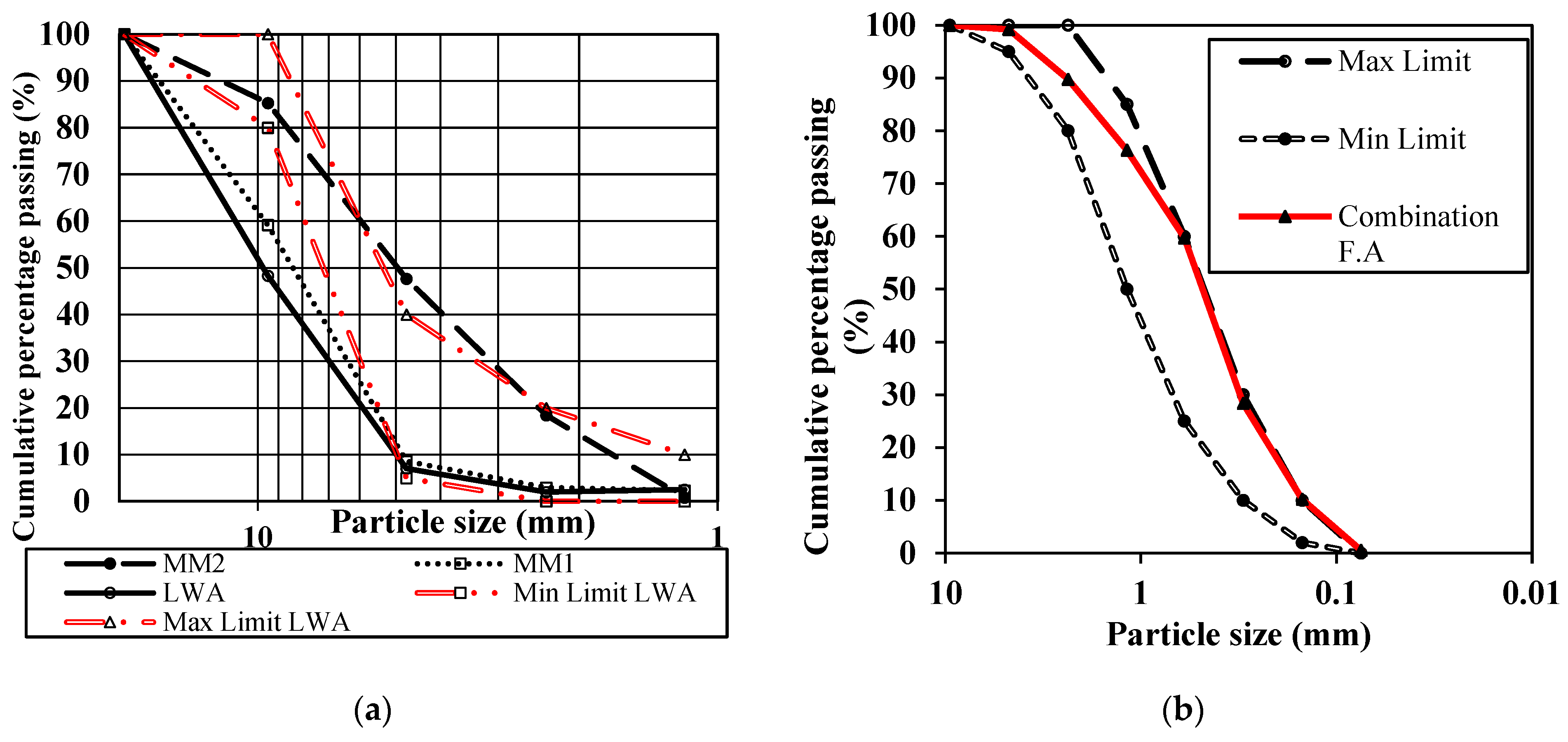
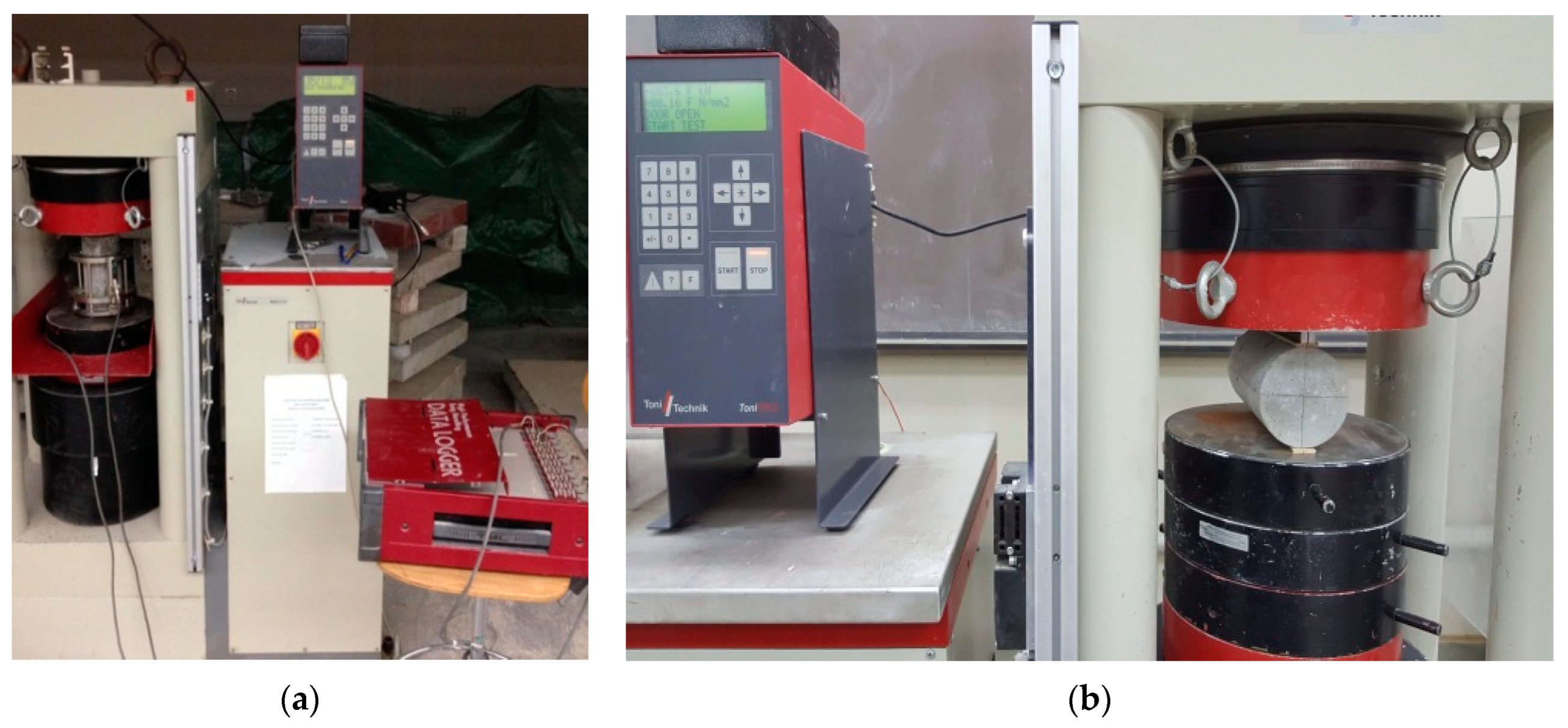
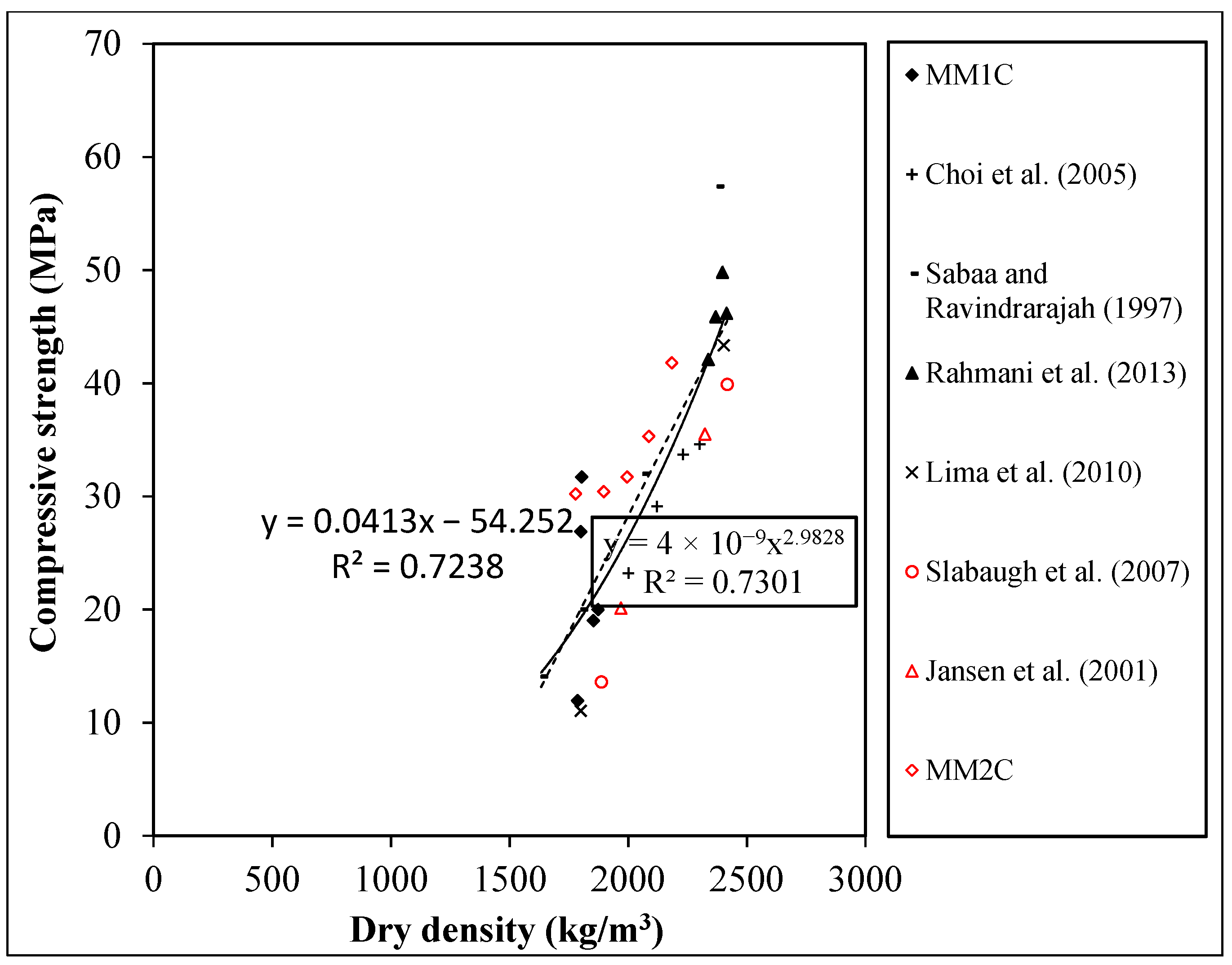
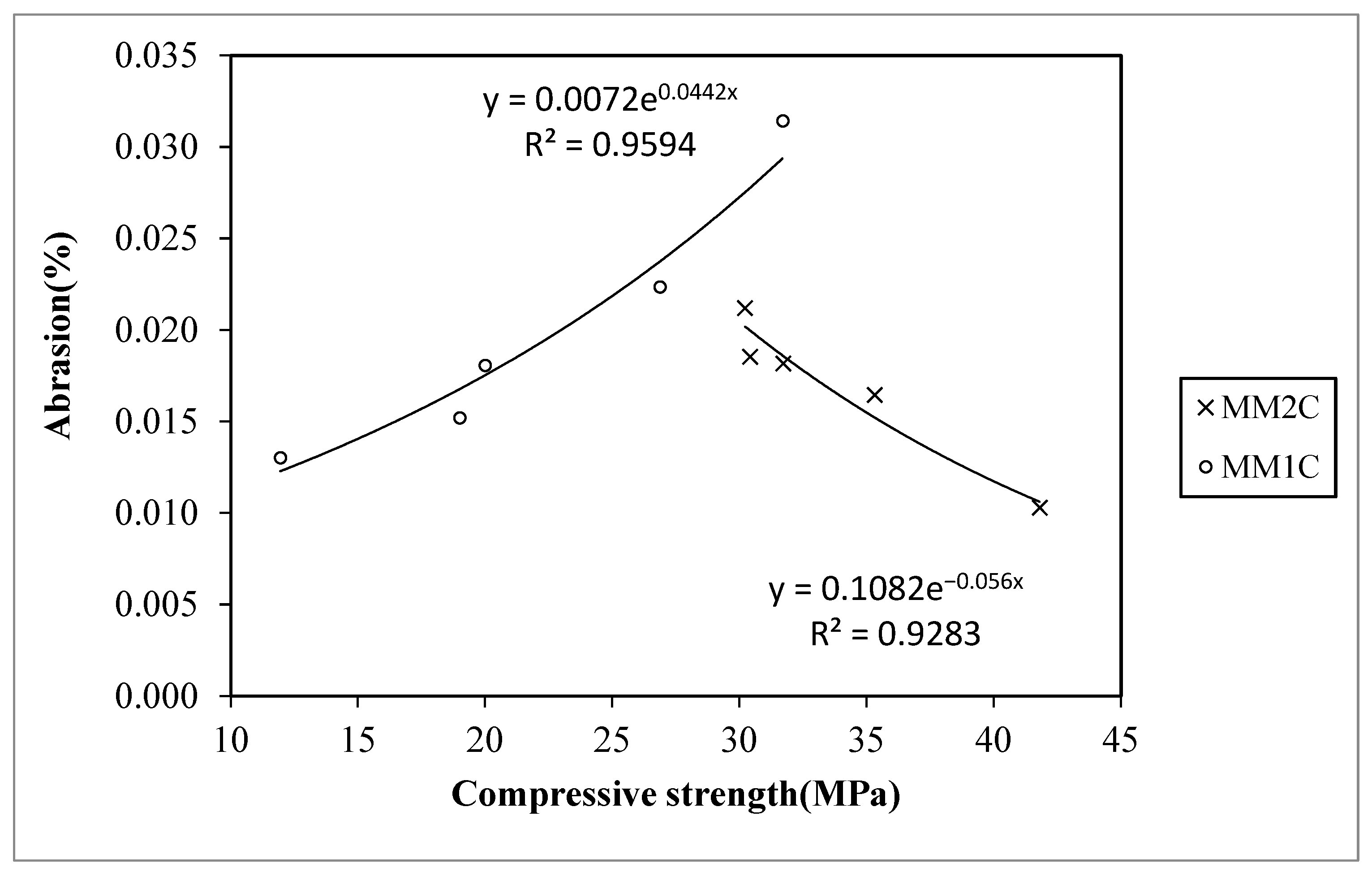
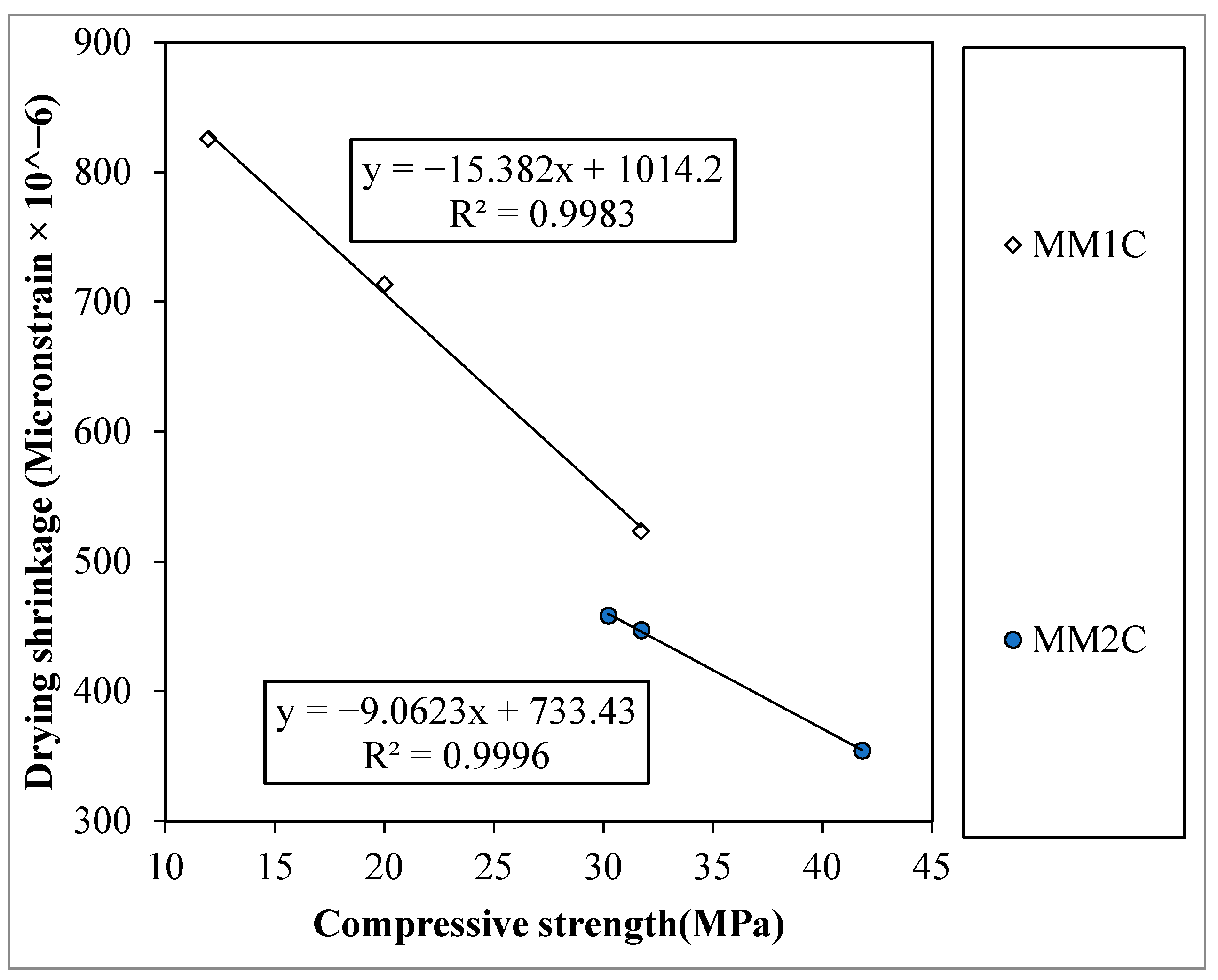
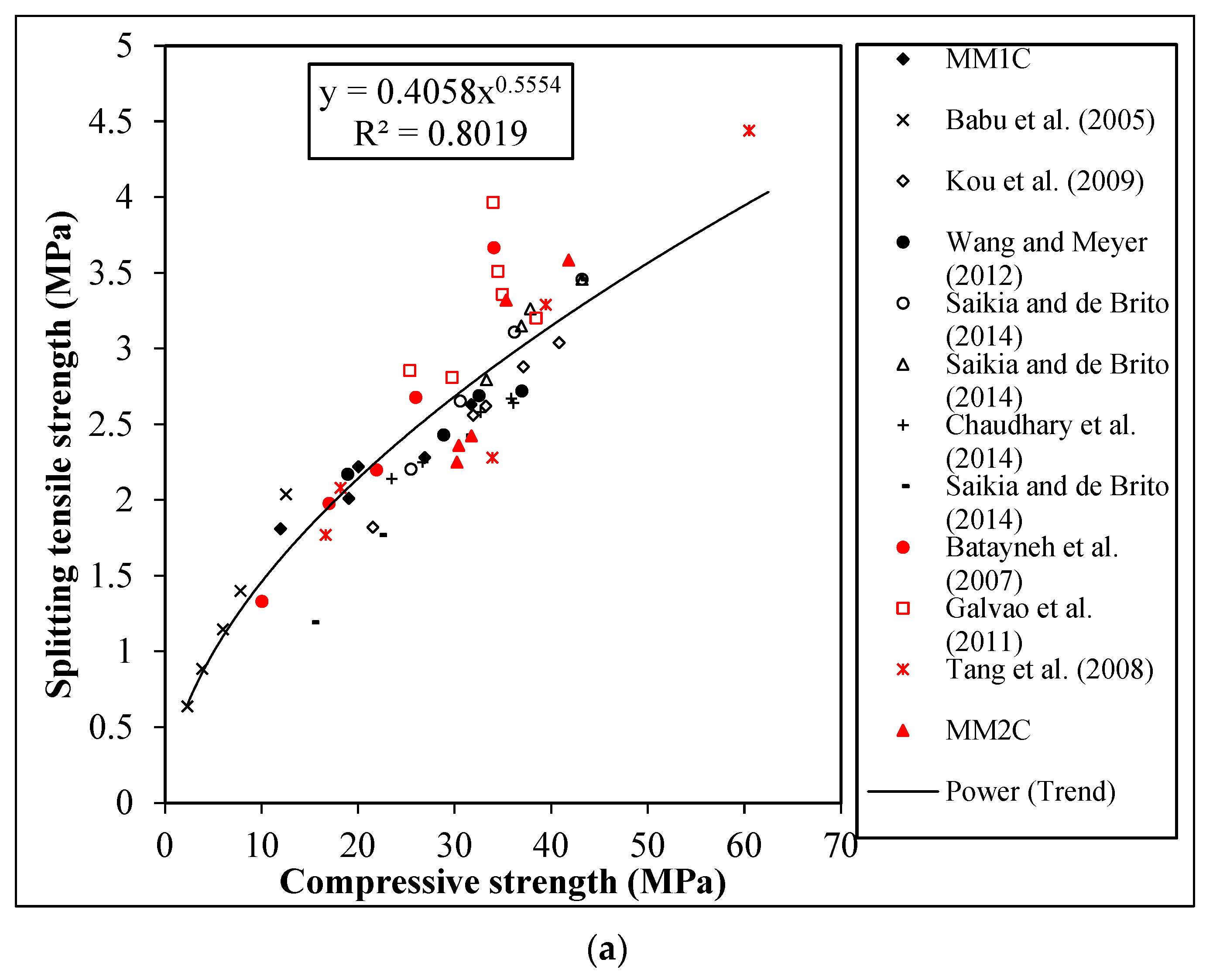


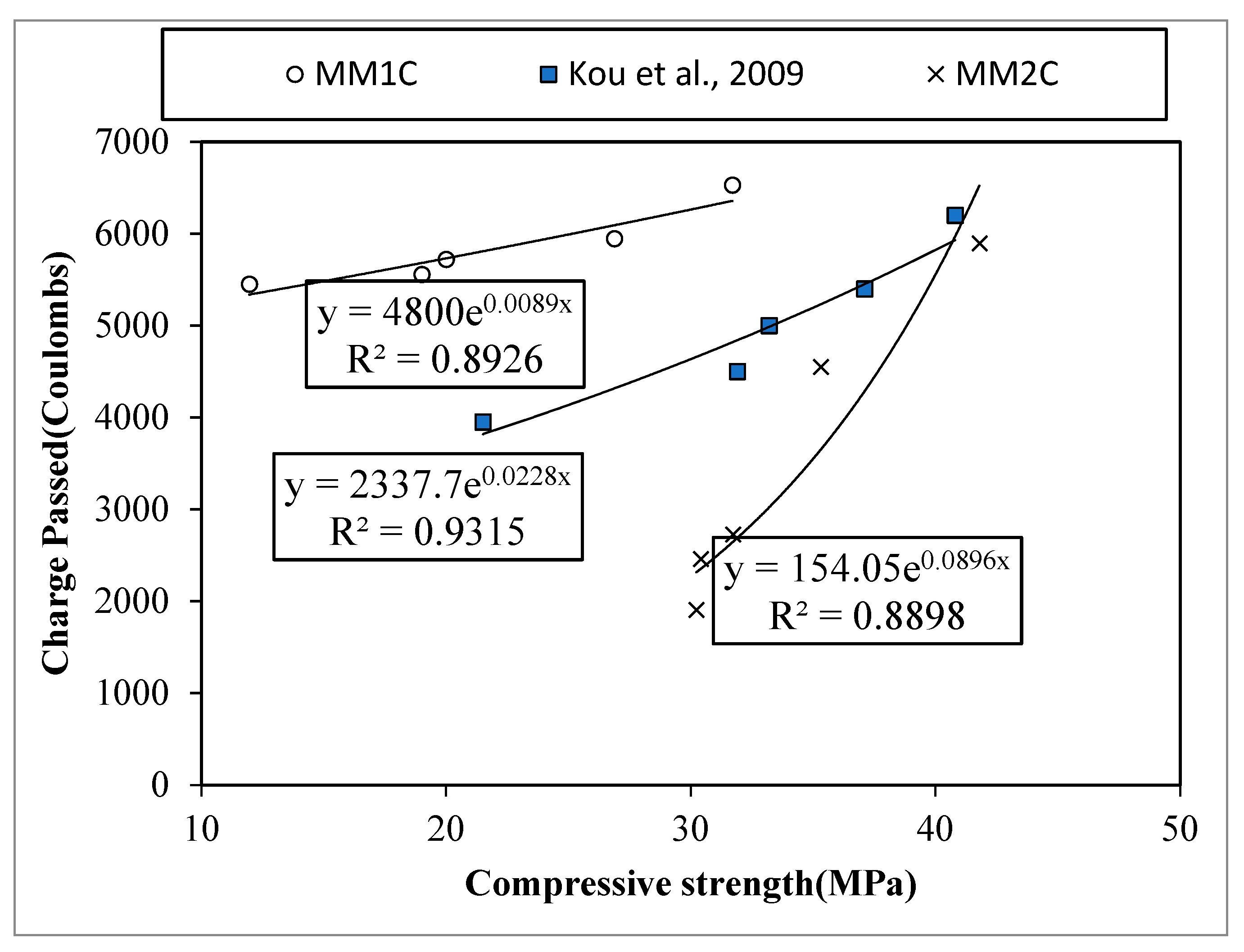

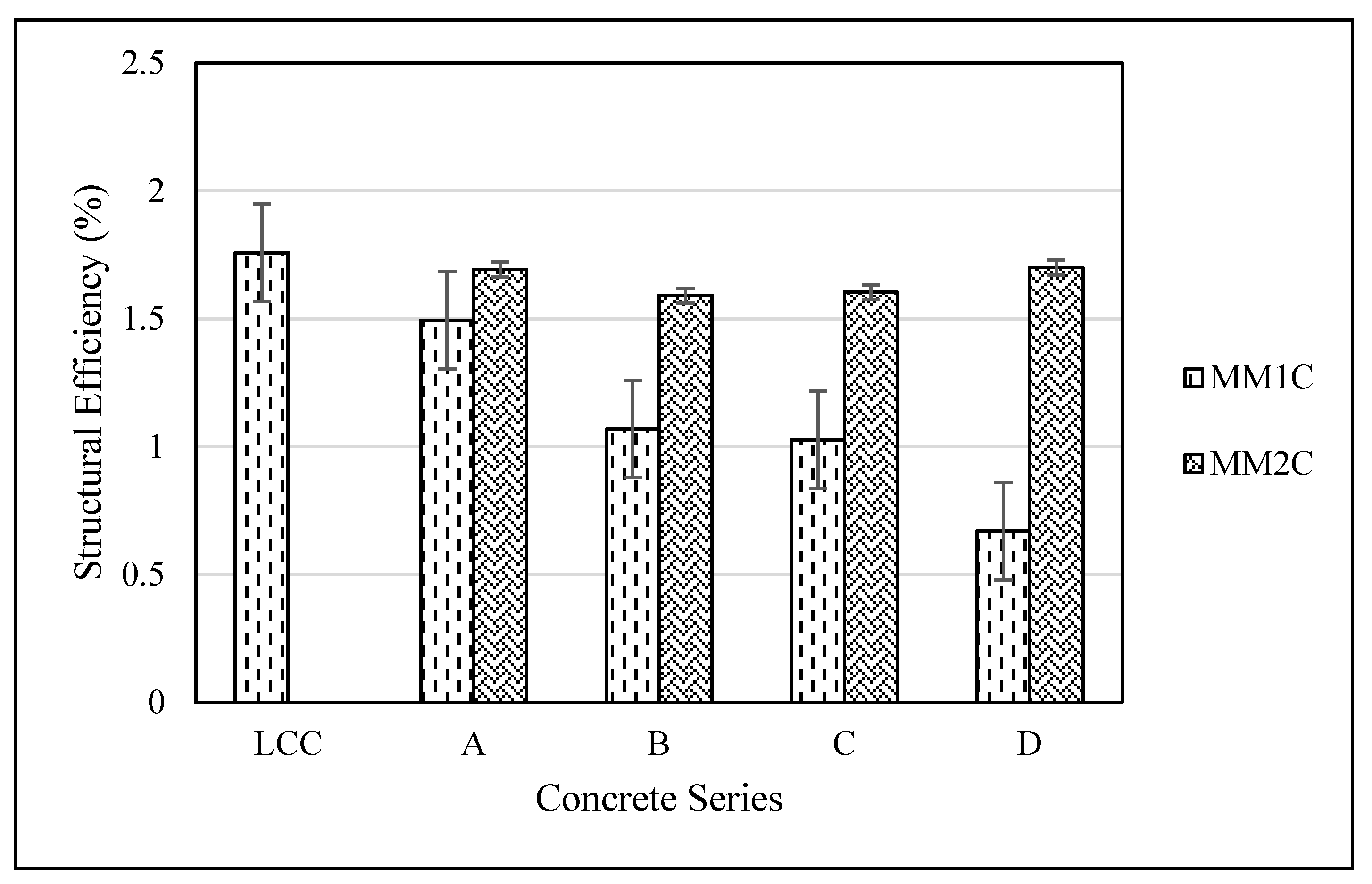
| Concrete Type | Green Manmade Plastic Aggregate | Mechanical Aspect | Durability Aspect | |||
|---|---|---|---|---|---|---|
| Plastic Type | Plastic Percentage | Filler Type | Filler Percentage | Compressive Strength (MPa) | Chloride Ion Resistance (Columns) | |
| Normal Weight | - | - | - | - | 43.70 | 5673 |
| Lightweight | - | - | - | - | 30.09 | 5811 |
| C1 | LLDPE | 50 | DS | 50 | 15.48 | 5532 |
| C2 | LLDPE | 50 | QF | 50 | 17.58 | 5859 |
| C3 | LLDPE | 30 | DS | 70 | 15.24 | 5227 |
| C4 | LLDPE | 30 | QF | 70 | 18.02 | 5875 |
| C5 | PET | 50 | DS | 50 | 35.92 | 3996 |
| C6 | PET | 50 | QF | 50 | 39.09 | 3612 |
| C7 | PET | 30 | DS | 70 | 25.67 | 3647 |
| C8 | PET | 30 | QF | 70 | 31.74 | 3417 |
| Properties | Filler Type | |
|---|---|---|
| DS | QFF | |
| Color | Reddish | Creamy Whitish |
| Specific gravity | 2.62 | 2.71 |
| Median size (µm) | 215 | 19.27 |
| Absorption (%) | 0.38 | 1.52 |
| Shape | Irregular | Angular |
| Density (kg/m3) | 1649 | 1531 |
| Concrete Type | W/C | Total Water | Free Water | Cement | Fine Aggregate | Coarse Aggregate | ||
|---|---|---|---|---|---|---|---|---|
| N | L | MMP | ||||||
| kg/m3 | ||||||||
| LCC | 0.50 | 296.2 | 225 | 450 | 922 | - | 352 | - |
| MM1CA | 282.4 | 918 | - | 264 | 95 | |||
| MM1CB | 269.6 | 913 | - | 176 | 189 | |||
| MM1CC | 255.6 | 909 | - | 88 | 284 | |||
| MM1CD | 241.1 | 906 | - | - | 378 | |||
| NCC | 240.3 | 880 | 688 | - | - | |||
| MM2CA | 239 | 847 | 516 | - | 141 | |||
| MM2CB | 237.6 | 815 | 344 | - | 282 | |||
| MM2CC | 236.2 | 782 | 172 | - | 423 | |||
| MM2CD | 234.8 | 750 | - | - | 565 | |||
| Sr. No | Parameter | Procedure Adopted |
|---|---|---|
| 1 | Dry density | BS EN 12390-7:2009 [29] |
| 2 | Cylinder compressive strength | ASTM C39/C39M-16 [30] |
| 3 | Flexural strength | ASTM C580-02 [31] |
| 4 | Splitting tensile strength | ASTM C496/C496M-11 [32] |
| 5 | Modulus of elasticity | ASTM C469/C469M-14 [33] |
| 6 | Abrasion resistance | ASTM C944/C944M-12 [34] |
| 7 | Chloride permeability | ASTM C1202-12 [35] |
| 8 | Thermal conductivity | ASTM C177-13 [36] |
| Concrete Type | Predicted Values by Using the Figure 4 Eqs. | Percentage Difference between Predicted and Experimental Results | |
|---|---|---|---|
| LCC | 0.029 | - | −7.89 |
| MM1CA | 0.023 | - | 4.75 |
| MM1CB | 0.017 | - | −4.19 |
| MM1CC | 0.017 | - | 9.04 |
| MM1CD | 0.012 | - | −6.61 |
| NCC | - | 0.011 | 2.73 |
| MM2CA | - | 0.015 | −7.72 |
| MM2CB | - | 0.019 | 1.97 |
| MM2CC | - | 0.020 | 7.46 |
| MM2CD | - | 0.020 | −4.99 |
| Concrete Type | Predicted Values by Using the Figure 5 Eqs. (Micronstrain × 10−6) | Percentage Difference between Predicted and Experimental Results | |
|---|---|---|---|
| LCC | 526.59 | - | 0.58 |
| MM1CC | 706.56 | - | −1.02 |
| MM1CD | 830.39 | - | 0.53 |
| NCC | - | 354.63 | 0.04 |
| MM2CC | - | 445.97 | −0.26 |
| MM2CD | - | 459.57 | 0.22 |
| Concrete Type | Predicted Values by Using the Equation in | Percentage Difference between Predicted and Experimental Results | ||
|---|---|---|---|---|
| Figure 6a | Figure 6b | Figure 6a | Figure 6b | |
| LCC | 2.63 | 2.79 | 5.92 | 5.00 |
| MM1CA | 2.28 | 2.56 | 12.42 | 10.51 |
| MM1CB | 2.22 | 2.21 | −0.53 | −3.69 |
| MM1CC | 2.01 | 2.15 | 7.07 | 3.41 |
| MM1CD | 1.81 | 1.70 | −5.91 | −11.25 |
| NCC | 3.58 | 3.20 | −10.64 | −10.15 |
| MM2CA | 3.32 | 2.94 | −11.42 | −11.70 |
| MM2CB | 2.42 | 2.79 | 14.92 | 13.93 |
| MM2CC | 2.36 | 2.73 | 15.55 | 14.30 |
| MM2CD | 2.25 | 2.72 | 20.85 | 19.51 |
| Concrete Type | Predicted Values by Using the Equation in | Percentage Difference between Predicted and Experimental Results | ||
|---|---|---|---|---|
| Figure 7a | Figure 7b | Figure 7a | Figure 7b | |
| LCC | 4.62 | 4.62 | −24.81 | −24.88 |
| MM1CA | 4.22 | 4.12 | −6.54 | −8.74 |
| MM1CB | 3.57 | 3.35 | −4.26 | −10.27 |
| MM1CC | 3.47 | 3.23 | −1.68 | −8.51 |
| MM1CD | 2.68 | 2.33 | −22.68 | −32.54 |
| NCC | 5.40 | 5.61 | −0.37 | 3.45 |
| MM2CA | 4.91 | 4.98 | −6.25 | −4.92 |
| MM2CB | 4.63 | 4.62 | −8.17 | −8.24 |
| MM2CC | 4.52 | 4.49 | 1.15 | 0.48 |
| MM2CD | 4.50 | 4.47 | 12.72 | 11.88 |
Publisher’s Note: MDPI stays neutral with regard to jurisdictional claims in published maps and institutional affiliations. |
© 2022 by the author. Licensee MDPI, Basel, Switzerland. This article is an open access article distributed under the terms and conditions of the Creative Commons Attribution (CC BY) license (https://creativecommons.org/licenses/by/4.0/).
Share and Cite
Alqahtani, F.K. A Sustainable Alternative for Green Structural Lightweight Concrete: Performance Evaluation. Materials 2022, 15, 8621. https://doi.org/10.3390/ma15238621
Alqahtani FK. A Sustainable Alternative for Green Structural Lightweight Concrete: Performance Evaluation. Materials. 2022; 15(23):8621. https://doi.org/10.3390/ma15238621
Chicago/Turabian StyleAlqahtani, Fahad K. 2022. "A Sustainable Alternative for Green Structural Lightweight Concrete: Performance Evaluation" Materials 15, no. 23: 8621. https://doi.org/10.3390/ma15238621
APA StyleAlqahtani, F. K. (2022). A Sustainable Alternative for Green Structural Lightweight Concrete: Performance Evaluation. Materials, 15(23), 8621. https://doi.org/10.3390/ma15238621





